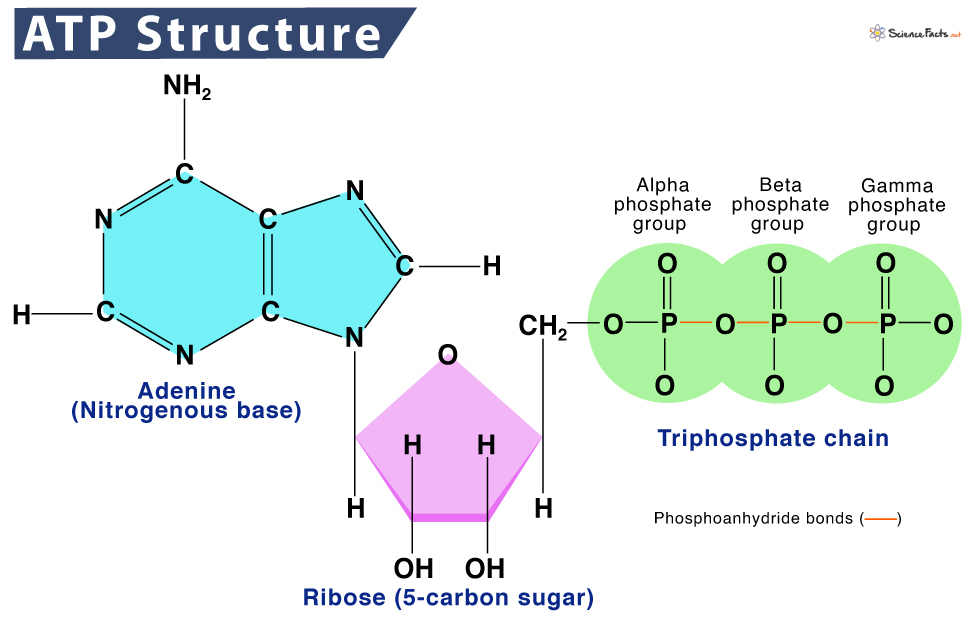Adenosine Triphosphate (ATP)
Adenosine triphosphate, abbreviated ATP, is an organic molecule that supplies energy for all cellular activities in plants, animals, and lower organisms. These molecules capture the stored chemical energy of digested foods and later release it for various cellular processes. Such processes include transport, muscle contraction, nerve impulse propagation, phosphorylation, and synthesis. Thus, it is known as the energy currency of the cell. It also acts as the phosphate donor and the signaling molecule inside the cell.
In 1929, German chemist Karl Lohmann discovered ATP. According to Karp, the human body produces more than 2 x 1026 molecules or more than 160 kg of ATP.
Structure of Adenosine Triphosphate (ATP)
Components
ATP is a macromolecule known as a nucleic acid that is made of three main components or parts:
- Adenine, a nitrogenous base
- Five-carbon ribose sugar
- A triphosphate chain consisting of three phosphate groups
The three phosphate groups are labeled alpha, beta, and gamma from closest to furthest from the ribose sugar. The bonds between these phosphate groups are high-energy phosphoanhydride bonds. When these bonds are broken, they release, which powers various cellular processes.
Synthesis of ATP
ATP is formed in two main ways involving multiple biochemical pathways. ATP production can occur in the presence of oxygen from cellular respiration, beta-oxidation, ketosis, lipid, and protein catabolism, as well as under anaerobic conditions. However, large amounts of adenosine triphosphate (ATP) are generated when the cells function in the presence of adequate oxygen.
1. Substrate-level Phosphorylation
Here, the phosphate group is directly transferred from a substrate to ADP, producing ATP. It occurs in glycolysis and the citric acid cycle during cellular respiration.
In Glycolysis
It occurs in two different steps:
Step 1: Conversion of 1,3-bisphosphoglycerate to 3-phosphoglycerate catalyzed by the enzyme phosphoglycerate kinase.
- 1,3-bisphosphoglycerate + ADP + Pi → 3-phosphoglycerate + ATP
Step 2: Conversion of phosphoenolpyruvate to pyruvate catalyzed by pyruvate kinase
- Phosphoenolpyruvate + ADP + Pi → pyruvate + ATP
In Krebs Cycle
It occurs in only one step:
Conversion of succinyl-CoA to succinate catalyzed by the succinyl-CoA synthetase
- Succinyl-CoA + GDP + Pi → succinate + GTP + CoA
Under scarcity or absence of oxygen, cells produce ATP through anaerobic respiration. Due to the accumulation of NADH, pyruvate is reduced to lactate by lactic acid fermentation. In lactic fermentation, the two molecules of NADH created in glycolysis are oxidized to maintain the NAD+ reservoir, producing two molecules of ATP per glucose molecule.
2. Oxidative Phosphorylation
Along with oxidative phosphorylation, the electron transport chain synthesizes most ATP during aerobic cellular respiration within the mitochondrial matrix. It generates approximately thirty-two ATP molecules per molecule of glucose that is oxidized.
The energy needed for ATP synthesis comes from a proton gradient across the inner mitochondrial membrane. The concentration of protons in the intermembrane space is higher than in the matrix. As the protons move down the gradient through ATP synthase (ATPase), the energy powers the synthesis of ATP to ADP.
Some common pathways that produce ATP through oxidative phosphorylation in the cell are:
In Beta-Oxidation
Throughout each cycle, the fatty acid is decreased by two carbon lengths, producing one molecule of acetyl-CoA. Oxidation of acetyl-CoA through the citric acid cycle produces one molecule each of NADH and FADH2. These electron carriers produce ATP through oxidative phosphorylation.
In Ketosis
It releases ATP through the oxidation of ketone bodies. During the process, ketone bodies generate twenty-two ATP molecules and two GTP molecules per acetoacetate molecule oxidized.
Hydrolysis of ATP
It describes how ATP becomes ADP through hydrolysis. This process is just the opposite of ATP synthesis.
How is Energy Released From a Molecule of ATP
When the phosphoanhydride bonds are broken, they release sufficient energy to power various cellular processes. The gamma and beta phosphate bond contains the highest energy among the three. When this bond breaks, it produces adenosine diphosphate (ADP) and one inorganic phosphate group (Pi).
How does Adenosine Triphosphate become Adenosine Diphosphate
ATP + H2O → ADP + Pi + free energy
Functions of ATP
Main Importance
The primary role of ATP in a cell is its energy source for carrying out all cellular and metabolic processes.
Other Purposes
1) Intracellular Signaling: It serves as a substrate for kinases. When a kinase phosphorylates a protein, a signaling cascade can be activated, leading to various intracellular signaling pathway changes. Some examples of signaling pathways that require ATP are:
2) Signal Transduction: As a signaling molecule, ATP induces numerous signaling pathways and helps cell communication.
3) DNA and RNA Synthesis: The synthesis of both the genetic materials, DNA and RNA, require energy obtained from ATP
4) Preserving Cell Structure: ATP helps preserve the cell’s structure by helping assemble the cytoskeletal elements.
Besides cellular functions, ATP also has substantial clinical significance, such as a pain controller, a supplement during anesthesia, and a pulmonary vasodilator in patients affected by pulmonary surgery.
FAQs
Ans. 38 ATP molecules are produced in aerobic respiration.
Ans. 32 ATP molecules are produced in the electron transport chain.
Ans. No, ATP is not a protein.
Ans. The aerobic cellular respiration pathway provides the longest-lasting supply of ATP.
Ans. No, ATP is not an amino acid.
Ans. No, ATP is not an electron carrier.
Ans. No, ATP is not an enzyme.
Ans. No, ATP is not a carbohydrate.
Ans. No, ATP is not a lipid.
-
References
Article was last reviewed on Thursday, May 9, 2024




